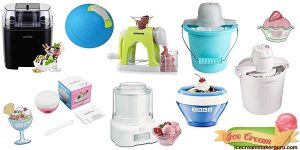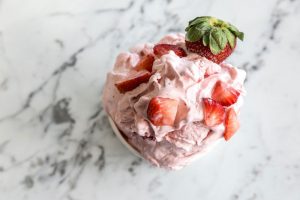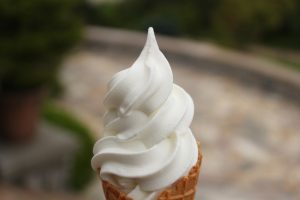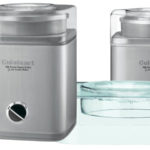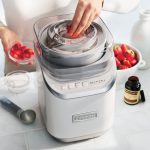Cuisinart ICE-30BC Ice Cream Maker Review - Based on all reviews and technical specifications Cuisinart…
Homemade Ice Cream Fails — Your Problems Solved
If you’re new to experimenting with homemade ice cream, chances are, a flop or two will occur. Whether you’re using the best ice cream maker or not, some common errors have challenged many ice cream makers since then.
In this guide, we are going to highlight commonly-known mistakes in homemade ice cream making and their solutions! If you want a fantastic and flawless result, you should familiarize yourself with these ice cream making fails!
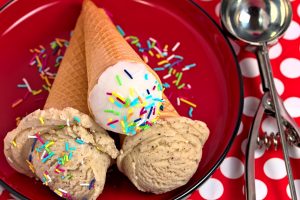
Ice Cream Fail #1: Too Crunchy
The Problem: Ice Crystallization
The formation of large unwanted crystals is probably one of the most common issues ice cream lovers face when making their ice cream at home. Tiny ice crystals form during the production process, and they make up the body of your ice cream. There are two reasons why these tiny crystals turn large: an unbalanced recipe and slow freezing time.
When your mix has too much free-flowing water, large crystals will form when it binds during freezing. To avoid this, follow recipes precisely or try another one if your finished batch still ends up crunchy.
Right after churning, ice crystals are at their smallest. However, they keep growing from there. If your mixture freezes too slowly, the ice crystals will double or even triple in size, leaving you with crunchy, gritty, and icy ice cream.
Ice Cream Fail #2: Too Hard
The Problem: Not Enough Fat
If you found your ice cream too hard, there’s probably not enough fat content in your homemade ice cream mixture. To achieve that dreamy, creamy texture, you need to have the right amount of milk and butterfat in there. If you want a fat-free dessert, ice cream might not be the best choice for you, then. It’s better to pile that fat up and eat a smaller portion than leaving it all out!
Ice Cream Fail #3: Too Soft
The Problem: Low Freezing Temperature, Fat Content, Sugars, and Alcohol
- When your ice cream doesn’t want to freeze, some factors could be the culprit. The first is faulty temperatures. When making homemade recipes, it’s common to have your ice cream too soft since you don’t have the high-end machines that professionals do. So, you have to be extra precise when following steps. Ensure that the bowl in your machine is ice cold before adding an even colder ice cream mix. If one of these is too warm, there’s a big chance that your homemade ice cream will stay soft or even not freeze at all! Your refrigerator should be set to a very low temperature as well.
- Increasing the fat content in your ice cream will help it freeze and stay hard. Ice cream is mainly made from air and fat, and the last tends to melt slowly. If you’re skimping on the fat part for health reasons, you’ll soon end up with a melted mess.
- Both alcohol and sugar take a long time to freeze. If your mixture has too much of these, you’ll end up with your ice cream not freezing.
Read full review: Cuisinart ICE-70 Ice Cream Maker
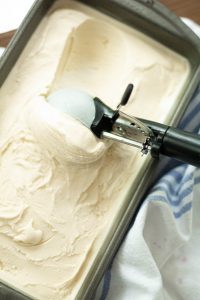
Ice Cream Fail #4: Has Fat Globules
The Problem: Oil-based ingredients
If your homemade ice cream has tiny milk-fat dots floating around in it, you’ve probably missed the peak window of your oil-based ingredients while making it. To get this step right, you need to properly emulsify your mix while it’s still warm. Once it’s in the ice cream maker, keep a close eye on it to get it out once it’s at its creamiest, pre-glob consistency. Recipe times vary depending on your machine, so regularly checking in on your mix is a must!
Ice Cream Fail #5: Gritty Add-Ins
The Problem: Store-bought Candies
The only thing worse than ice cream being too hard is biting into hard candy or chocolate pieces when you’re enjoying a creamy batch. While add-ins can elevate your homemade ice cream, store-bought candies and chocolates rarely do well at sub-zero temperatures. Besides leaving them out, making your own add-ins is the best solution. By doing this, you can formulate your recipes for the freezing.
Ice Cream Fail #6: Greasy, Weak or Watery Ice Cream
The Problem: Abundance or Lack of Ingredients
If your ice cream leaves a greasy, unpleasant taste in your mouth, you probably have too much butterfat in it. When you’re making ice cream at home, you must check the butterfat content.
If your ice cream is watery and lacks body, it probably doesn’t contain enough solids. Adding skimmed powder milk or a stabilizer can help with this. A pinch of salt will also elevate your ice cream’s flavor!
Ice Cream Fail #7: Foamy Ice Cream
The Problem: Air Bubbles
While air makes ice cream creamier and softer, it can also leave it foamy. Small bubbles form in bulk when air doesn’t mix with the other ingredients in your ice cream. This uneven mixture leads to a foamy consistency. When making ice cream at home, you need to ensure that you fill up your machine about three-quarters full. Any less, you’ll end up with foamy ice cream; any more, and your homemade ice cream mix won’t be creamy.
Read full review: Cuisinart ICE-30BC Pure Indulgence Ice Cream Maker
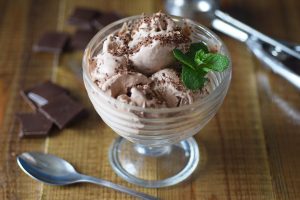
Conclusion
When you’re making ice cream at home, it’s not surprising that some processes might fail. It can be frustrating to face failure, especially when you’re not sure what went wrong! Experimenting with ice cream should be fun, and when you’re an at-home ice cream maker, it’s highly recommended.
To avoid common ice cream making mistakes, it’s a good idea to familiarize yourself with them and their solutions. All domestic ice cream machines can make great ice cream, and if you know how to use them right, you’re only left with perfecting your ice cream mixture. Using well-prepared recipes, getting your mixture ice cold before mixing it in the machine, and ensuring that your machine and refrigerator are at their optimal temperature will yield excellent results.
Once you’ve perfected a basic ice cream recipe, use your newfound knowledge to experiment with different flavors and add-ins to make the best homemade ice cream there is!
Join Me In The Fun of Making Ice Cream at Home!
Hi, my name is Simone and I LOVE making and eating ice cream. I have searched long and hard to find the best ice cream maker reviews and tips on the best ice cream makers.
Find out a little more about myself and the IceCream Maker Guru gang here.
Thanks for visiting and may your ice cream always be delicious!
Simone xx
Categories
Recent Posts
Most Popular Posts
Share with Friends
Related Posts
-
Cuisinart ICE-30BC Ice Cream Maker Review
-
Tips for Perfect Homemade Ice Cream
Making home made ice cream in the comfort of your own home is becoming more…
-
Cuisinart Ice Cream Maker Comparison – Find the Best Cuisinart Ice Cream Maker for You
Money can never go wrong when you want to invest in a Cuisinart ice cream…

